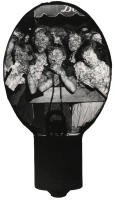
John Loengard, Cartier-Bresson takes pictures in his Paris apartment, 1987 (239.1987)
When we see a photograph of a photographer at work, questions can be raised about the relationship between the photographer, his camera, and the referent. Especially when the eyes of the photographer are hidden by the camera and its lens is facing straight at us, we wonder . . . are we looking at a self-portrait, taken while looking in a mirror? Or is it a portrait of a colleague-photographer?

Andreas Feininger, The Photojournalist, 1951 (2011.78.11)
Andreas Feininger’s photograph The Photojournalist stresses the “unity” between the photographer’s eyes and the lens of his camera. It depicts the photographer as a sneak safely hidden behind the camera, which not only covers but also replaces the eyes. The fusion of the lens and the eye is nothing new. Since the beginning of photography, the lens of the camera has been compared with human vision. In the nineteenth century, before knowing that the human brain creates the images we see, people believed that the images they saw appeared on the retina. That’s probably why Joseph Nicéphore Niépce referred to the camera he was building in 1816 as an artificial retina, while the images, which could not yet be fixed, he called “retinas.”

Chim (David Seymour), [Actress Ingrid Bergman sitting on a sofa under the reflection of the photographer, Cannes, France], 1956 (45.1990)
Like Feininger’s photograph, Chim’s mirror portrait of Ingrid Bergman presents the camera as the photographer’s eye, but it makes us also aware of “sharing” our eyes with those of the photographer. Same goes for the photographs by Harold Feinstein and Lee Friedlander, who show the reflection of the photographer at work. It is like standing next to them; we can image their presence and their position of the moment the image was shot. By including themselves and their camera into the subject of the image, and thus becoming the referent in the photograph, these photographers show how and where the photograph was taken.

Harold Feinstein, Hairdresser in Window / Philadelphia, 1964 (597.1982)



Pingback: Harold Feinstein Photographer - Upon reflection: Getting into the picture you're taking